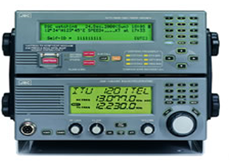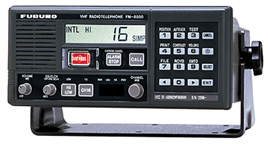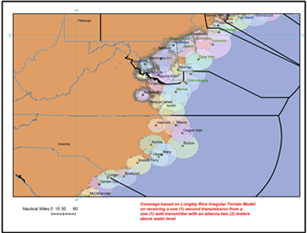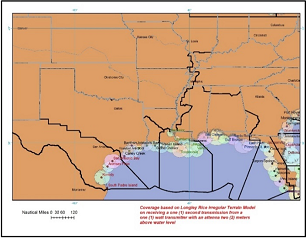The Drill Down, Issue #21: DSC Distress Alerting
 What is DSC?
What is DSC?
 Digital Selective Calling (DSC) is a function used to call and transmit pre-defined digital messages via maritime Very High Frequency (VHF) (image left) and Medium Frequency (MF)/High Frequency (HF) (image right) frequencies and radio equipment.
Digital Selective Calling (DSC) is a function used to call and transmit pre-defined digital messages via maritime Very High Frequency (VHF) (image left) and Medium Frequency (MF)/High Frequency (HF) (image right) frequencies and radio equipment.
The International Maritime Organization (IMO) introduced DSC as a required function on VHF, MF and HF maritime radios as part of the Global Maritime Distress and Safety System (GMDSS) compliance requirement.
DSC is an immediate means of transmitting a distress alert from a vessel in distress to other vessels in the vicinity and to coast stations within range of the DSC distress alert. It may be used for placing routine and urgency calls to other vessels or coast stations equipped with DSC, as well as for relaying distress alerts to other vessels and coast stations.
DSC Requirements
DSC was originally required on vessels compliant with GMDSS. However, at the request of the U.S. Coast Guard, the FCC ordered that all type-accepted marine radios sold or installed on or after June 17, 1999, have DSC capabilities. This means that every new marine VHF and MF/HF radio installed aboard a vessel after 1999 would be DSC capable.
Watch Requirements
DSC was initially intended to replace the listening watch requirements of 2182 kHz on MF radio and Ch. 16 on VHF radios for voice distress calls. The watch requirement for 2182 kHz was allowed to end in 1999, however, the listening watch requirement on VHF Ch. 16 continues.
DSC continuous watch requirements for GMDSS-compliant vessels while at sea are VHF DSC Ch. 70 and, depending on Sea Areas of operations, 2187.5 kHz on MF and/or HF 8414.5 kHz and at least one other high frequency of the operator’s choice. The other HF options are 4207.5, 6312, 12577 and 16804.5 kHz.
The continuous DSC watch on each maritime VHF and MF/HF radio is done automatically by a dedicated scanner or built-in receiver that monitors the DSC distress channels and frequencies without requiring the operator to physically listen to them.
Distress Alerting Information
By simply hitting the red “Distress” button on a DSC-equipped radio (images above), a preformatted DSC distress alert would be sent out to all vessels and coast stations within radio range of the VHF or MF/HF DSC radio transmitting the alert.
If time permits, there are additional menu options for the operator to select and format the distress alert with more information regarding the nature of the distress.
The location of the vessel in distress would be automatically provided if a GPS receiver is connected to the radio. If not, the location would require manual input at least every four hours as required by 47 CFR 80.1085(c).
The identity of the vessel is by a nine-digit Maritime Mobile Service Identity (MMSI) number issued by the FCC, programmed into the DSC equipment and is the same number used for the vessel’s Automatic Identification System (AIS).
Coast Guard DSC Watch
On January 20, 2015, the Coast Guard declared Sea Area A1 for most coastal areas off the coast of the U.S. based upon the Rescue 21 Distress System Coverage (USCG Fifth District (below left) and USCG Eighth District (below right)). This gives coverage to many coastal areas of the U.S. for the Coast Guard to monitor for VHF Voice and DSC distress alerts. A complete list of coverage areas is available at www.navcen.uscg.gov/rescue-21-distress-system-coverage.


The Coast Guard terminated its watch on Medium Frequencies (MF); Voice 2182 kHz, DSC 2187.5 kHz and also terminated broadcasting of marine weather information broadcasts on 2670 kHz on August 1, 2013.
The Coast Guard also discontinued monitoring all High Frequency (HF) voice distress frequencies within the contiguous U.S. and Hawaii on February 7, 2022. However, HF voice distress watchkeeping continues in Alaska and Guam.
The Coast Guard continues to monitor HF DSC distress frequencies (4207.5, 6312, 8414.5, 12577 and 16804.5 kHz) along the coast of the U.S., including Alaska, Hawaii and Guam.
The following table lists the Coast Guard HF DSC Stations and MMSI numbers.
| Station |
MMSI |
| Universal USCG Shorebase ID |
003669999 |
| COMMCOM Chesapeake, VA/NMN |
003669995 |
| COMMSTA Boston, MA/NMF |
003669991 |
| COMMSTA Miami, FL/NMA |
003669997 |
| COMMSTA New Orleans, LA/NMG |
003669998 |
| COMMSTA Pt Reyes, CA/NMC |
003669990 |
| COMMSTA Honolulu, HI/NMO |
003669993 |
| COMMSTA Kodiak, AK/NOJ |
003669899 |
| USCG Sector Guam |
003669994 |
Distress Repetition and Acknowledgement
Once initiated, a DSC distress alert on VHF will be repeated automatically at intervals of about 4 minutes until it is either acknowledged by another station or stopped manually.
Distress acknowledgement by DSC should be reserved for the U.S. Coast Guard. However, a Ship Station can acknowledge a DSC distress call when it believes that no Coast Guard unit is within range or capable of acknowledging it. However, it is recommended that ships should not acknowledge it.
Conclusion
DSC is a vital system for distress alerting and urgent communications. Mariners should consider utilizing DSC for transmitting an immediate alert notification in the event of an emergency on board their vessel. Quick and timely notification of an emergency on board a vessel in distress provides for quick and timely response from those that are able to assist. DSC is likely the most efficient means of sending an ALERT. It is as important as other lifesaving equipment on board the vessel and it should be thoroughly inspected and prioritized as such.
Remember, just the simple push of the “Distress” button on the DSC equipped radio systems when a distress situation arises will alert other vessels in the vicinity and coast stations (Coast Guard) within range of the distress alert so they can respond appropriately and quickly.
Additional resources: See U.S. Coast Guard Marine Safety Alert 04-11 and Marine Safety Alert 03-23 regarding MMSI Numbers and GPS inputs into DSC equipped VHF radios. Also see the Navigation Center’s web page on Digital Selective Calling for more information on DSC test calls.
Readers should review 47 CFR Part 80, Subpart S for requirements on small passenger vessels, and 47 CFR Part 80, Subpart W for GMDSS requirements on cargo ships greater than 300 GT and all passenger ships.
Published 30Mar2023. Revision 1, 25Apr2023 (minor edits to graphics on the pdf version).